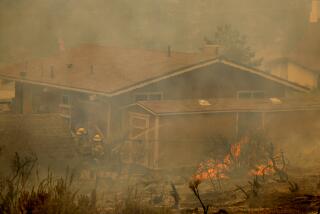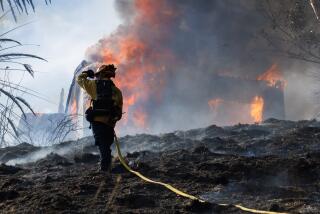Real Health for the Forests
There was no chance that the U.S. Senate, after seeing the blazing destruction in Southern California all week, was not going to pass some kind of forest protection bill. Thanks to the efforts of California’s senior senator, Democrat Dianne Feinstein, the final product won’t make things worse and could be of real help.
California suffers because of lack of funding to prune underbrush and remove excess fuels in forest and chaparral. The Senate plan that passed Thursday night would more than double federally authorized spending, to $760 million a year, for thinning and clearing federal forest lands of the dense underbrush and crowding that helps turn ordinary forest fires into catastrophes.
The amount is more than double the current level of spending. The bill sponsored by Feinstein, working with a bipartisan coalition, also would clear some of the bureaucratic and legal underbrush that can delay forest-clearing projects. It attempts to protect old-growth forests from logging under the guise of thinning.
Environmentalists were concerned that the protections were too weak. But the Senate version is far preferable to the House-passed measure, patterned after President Bush’s so-called Healthy Forests Initiative. The key now is whether the Senate members of a congressional conference committee stand firm when they meet with House members to write the final bill.
Currently, the U.S. Forest Service is forced to raid other accounts to pay the costs of firefighting, including using funds set aside for forest thinning. The Feinstein bill requires spending at least half the new money to clear buffer zones around communities, while the rest would go to protection of watersheds, endangered species habitat and removal of trees killed by insects and disease. The proportion for communities should be even higher, to ease environmental groups’ fears that the bill would become an excuse for logging mature timber on remote lands.
As Feinstein noted, forest fires become tamer the minute they hit areas that have been effectively thinned. A fire that moves slower and burns cooler is less likely to jump to homes. It also kills less wildlife and spares more trees than the firestorms that raged through dense and dead growth this week.
Much of the area burned in the fires was not national forest. Unlike the House bill, the Senate version does not prohibit use of its funds on nonfederal land. The Feinstein measure also asks communities to develop plans for clearing chaparral and other brush, including the use of controlled, deliberate burns, and to require the use of fire-resistant building materials.
No legislation can prevent devastating fires altogether. Drought and hot weather will conspire from time to time. The needed clearing will take years to accomplish. But preserving forests and saving houses near them is a game of percentages. Each effective step balances the odds a little better.
More to Read
Sign up for Essential California
The most important California stories and recommendations in your inbox every morning.
You may occasionally receive promotional content from the Los Angeles Times.










